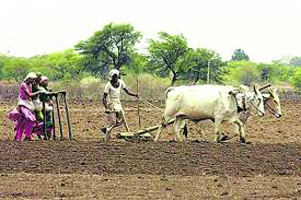Everyone in India knows that landlessness is inextricably linked to one’s caste position. This correlation goes back centuries, when agrarian labourers, especially Dalits and tribal people, lived a life of deprivation, without land rights, under malevolent zamindars and landlords.

Land reform is the most essential and fundamental step to get rid of caste oppression. Post-Independence, land reform measures have also had minimal success. For example, the 66th National Sample Survey Office (NSSO) survey showed that only 17.1 per cent of rural Scheduled Castes (SCs) own land as against 39.4 per cent of rural socially advanced classes (SACs). Conversely, 58.9 per cent of rural SC households are employed in agriculture as against 26.2 per cent rural SACs.
My organisation Rashtriya Dalit Adhikar Manch (RDAM)’s work in Gujarat over the past few years has facilitated the transfer of lands to its rightful owners, the landless peasants (not corporate machines).
Before addressing successive Gujarat governments’ pro-corporate sentiments that motivated many liberalisations in land reforms and deregulations post-1991, let us observe a peculiar regional unevenness that characterised Gujarat’s land distribution in the 1940s and 1950s. At the time, a part of present-day Gujarat was the United States of Kathiawar (or Saurashtra). U N Dhebar, its chief minister until 1956, led the peasants to a united Saurashtra struggle. The result of this movement was that the Patidar community, a landless Shudra community at the time, rose in power to become one of the dominant sections of Gujarat later. But in other parts of the state, especially northern Gujarat where I am an MLA, land reforms have been minimal.
Successive governments in Gujarat have shied away from doing the bare minimum to change this state of affairs. Most of their policies were even aimed at achieving, to borrow from the preamble to Gujarat Agricultural Land Ceiling (Amendment) Bill, 2015, “rapid industrialisation and urbanisation”.
Allowing corporate takeover
This process particularly gathered pace under Narendra Modi’s chief ministership to build the image of a business-friendly “Vibrant Gujarat”. In 2005, for instance, 46 lakh hectares of state-controlled grazing land and wasteland were transferred to private parties for non-agricultural use, or in cases where the land was used for cultivation, for corporate farming. Such corporate farming preys upon farmers while systematically ousting them from their lands and agriculture altogether; Pepsico India’s suing of nine farmers earlier this year is a case in point. These corporate takeovers affect not just the farmers, but also other sectors that employ unskilled labourers.
Under the 2005 government resolution, up to 2,000 acres of cultivable lands were transferred to industrial houses to establish industries or to farm for 20 years. Out of this, the first five years were rent-free and the levies for the remaining years were a meagre Rs 40-100 per acre. About 27,125 hectares were acquired for 60 special economic zones (SEZs) in Gujarat in 2014 under these new land regulations. These lands should have ideally gone to the landless agrarian labourers.
Gujarat’s Land Ceiling (Amendment) Act 2015 was, as experts have pointed out, framed to bypass the Land Acquisition, Rehabilitation and Resettlement (LARR) Act 2013. It seeks to transfer the remaining land surplus after reforms in 1960 to industrial houses instead of Dalit landless labourers. The government’s preferred beneficiaries are its corporate financiers and not the landless Other Backward Classes (OBCs), Dalits or tribal people.
These measures have resulted in the landless Dalits forming a sizeable proportion (71 per cent) of the population. They have been forced by their social and economic circumstances to continue working on the lands they possess on paper as mere daily wage workers while being abused and tortured by their caste Hindu landlords. Incidents of flogging and hate crimes characterise the social landscape of Gujarat more than most other Indian states. According to a reply to an RTI filed by activist Kaushik Parmar, atrocities against Dalits in Gujarat are prevalent not just in rural areas but also in cities like Ahmedabad. He has rightly remarked that the government’s claims of “samajik samrastha (social harmony)” in Gujarat is a big fat lie; every consistent political observer would second that claim.
Reversing years of social subjugation
Resentment towards these casteist anti-Dalit sentiments has resulted in many mass agitations and struggles. The Rashtriya Dalit Adhikar Manch was convened following a similar struggle in Una in 2016 to right these historical wrongs.
Since 2016, we have led struggles, especially in Kutch and Banaskantha districts, to secure the land allotted to Dalits decades ago but lying in the hands of feudal lords. Our cadre has been working tirelessly with these determined labourers and farmers to uplift their voices and reclaim their lands. Until now, we have been able to secure over 3,000 acres of land for Dalits, and farming has also started in many parts. For example, in Rapar region of Kutch, possession of 2,500 acres have been transferred to landless labourers, mostly Dalits, with the help of the local administration and the police. On 700 acres of these lands, cultivation has begun.
The RDAM set a new precedent in 2019 through a unique celebration of B.R. Ambedkar’s death anniversary. On 6 December, our units recaptured 100 acres of land from six villages in Botad, Bhavnagar, Amreli, Kutch and Banaskantha from feudal lords and awarded it to landless peasants, reversing years of social subjugation. The next phase of our ambitious venture is set to take place on Republic Day, 26 January, when we plan to recapture lands from 26 districts allotted to landless labourers, but just on paper.
It is my firm belief that as Ambedkarites, we must carry forward Babasaheb’s legacy by toiling to achieve his vision of annihilation of caste and to further his noble cause of building inter-caste harmony and equality through land struggle.
The author is an Independent MLA from Vadgam constituency, Gujarat. Views are personal.
Courtesy: The Print












